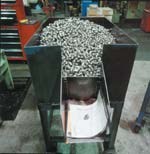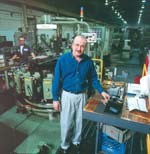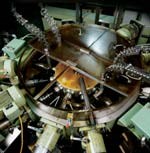A Formula For Success: Refocus, Size Down, Add Value
This cold former uses high production rotary transfer machines for value added machining. It's a very successful one/two combination.
Sometimes creating and maintaining a successful business strategy requires periodically dismantling it, putting it under the microscope and then reassembling it in not quite the original fashion, which is exactly what this custom component maker does, on a continuous basis.
Horizon Technology was formed 50 years ago as a small screw machine shop in Lincoln, Michigan. It's mission: to serve the automotive industry by producing a variety of turned parts—shafts, studs, fittings, rollers, pins, bushings, bolts and assorted fasteners. According to Mike Stoddart, division manager, the company grew steadily, and what was once a single shop became six divisions, four of which were screw machining operations and two of which were cold forming plants. The venture into cold forming was the idea of Ron Palmer, who bought the business from his father in 1975.
The move to cold forming some 15 years ago was a major change in the company's business strategy. With forming came value-added machining in the form of rotary transfer machines from Hydromat (St. Louis, Missouri). The idea was to form blanks on cold formers—National Machinery 1250 and 750 S3 models—and then add value by blank feeding the Hydromats to machine complex, precision secondary features. These two processes, cold forming and precision rotary transfer machining, took the company to new areas of opportunity—areas that feasibly could have been tapped by screw machine technology, but not as efficiently or profitably.
Parting With The Past
Two years ago Mr. Palmer broke with tradition and drove the company in a new direction. The four screw machine divisions were sold off to minority-owned RamaTech (Belleville, Michigan), which left Horizon with the two cold forming operations, one in Tiffin, Ohio, and the other in Wyandotte, Michigan, and a mandate to pursue new markets.
"This was not easy," says Mr. Stoddart. "Screw machining was the company's foundation—its roots—as was automotive. It's where we started, where we cut our teeth."
However, Mr. Stoddart says, by the late 1990s the screw machine business had become pretty brutal. It was overcrowded. The margins were often tight.
"In the end," Mr. Stoddart says, "we decided to sell to RamaTech, to size down and concentrate on what we knew we did best financially, and that was cold forming and value-added machining."
The impact of this decision can be read in the numbers. Horizon went from six divisions to two. Sales dropped from $90 million to around $50 million. Horizon, long associated with screw machine technology, now cast its fate with cold forming and value added machining. This clearly was an example of stepping out of a comfort zone. This was thinking on top of the box—risk taking.
Now, 2 years later, Horizon is on track to be a $100 million company within 3 to 4 years, which by any measure makes the shift in strategy—taking the risk—well worth any attendant anxiety.
Form Blanks, Add Value
One of the parts produced using a combination of cold forming and rotary transfer machining is a fuel component made of 409 stainless steel. A single cold former is dedicated to a cell of four 16-station HB 32/45-16 Hydromats.
According to Mr. Stoddart, ¾-inch diameter coiled wire is fed into the cold former. The formed blanks come off the former at about 100 a minute. The blanks drop into bins, and periodically an operator takes the parts and loads them into a feeder bin that feeds the parts into a bowl feeder. The parts are then oriented and fed down tracks and introduced to the first and eighth station of each Hydromat. With this arrangement, two parts are produced approximately every 6 seconds per machine.
"The four machines keep perfect pace with the cold former," Mr. Stoddart says. "We get completely finished components with no secondary operations required. We run millions of these a year."
Mr. Stoddart says there are four different varieties of this component. "We can intermix the four types pretty much at will," he says, "which gives us great machining flexibility. For example, we can run one part number across all four Hydromats, or one part number on each machine. Or, we can run any combination of the four. We have two high-volume jobs and two lower-volume ones. The process on the Hydromat is much the same from job to job. As long as the geometries of the formed blanks are fairly close, the Hydromats can handle them. The only thing that changes is the tooling, and that's usually a minor issue."
Another example of teaming a cold former and a rotary transfer machine is in the production of special nuts made from stainless steel. Here, a cold former feeds four different stations on a single HB 32/45-16. Mr. Stoddart explains that the parts exiting the cold former are fed to four different bowl feeders and feeder tracks, which then simultaneously feed four different stations on the Hydromat. The nut blanks are tapped, four at a time, in the rotary transfer machine.
The nut operation is an especially "lean" operation. A single operator runs the cold former and the 16-station transfer machine. Parts coming off the Hydromat are conveyored to a tumbling/cleaning process, and from there they automatically go through a rinse station. A machine vision station verifies thread presence, and then the nuts are automatically counted and boxed for shipment.
Secondary Machine, Primary Machine
One of the advantages of this rotary transfer technology is that you don't have to feed them pre-formed blanks, says Mr. Stoddart. "We feed them barstock as well." For example, a speedometer cable connector, made of 12L14, is run on an HW25-12 12-station machine. The machine is fed barstock, and operations include turning, drilling, cross drilling, slotting and milling. About 2 million connectors come off the rotary transfer machine every year.
In another bar application, an HB 32/45-16 machines a guide bushing for a steering component. Interesting here is that the rotary transfer machine does some assembly. "We turn these parts from barstock," Mr. Stoddart says, "and we buy a thin walled bronze bearing from an outside supplier. The bearing is fed via a bowl feeder and tracks to a station on the Hydromat where it gets pressed into the ID of the part. The guide bushing, the two parts together, come off the rotary transfer machine complete—no secondary operations."
This kind of capability doesn't surprise Mr. Stoddart. "We've got seven Hydromats," he says, "and the things that impress me are their durability—we run them 24 hours a day, 5 days a week—and their accuracy and repeatability. Their ability to hold dimensions and tolerances, day after day, just isn't an issue. Any part quality problems we may have usually are tool-related. My productivity runs right around 80 percent with these machines, which includes downtime for tool changes and light maintenance. And 80 percent is considered world-class in my business."
Partnering And Profits
Partnering is a technique that Horizon gives more than casual lip service to: It's the only way the company works, especially with its suppliers.
"When we launch a new job, for example, we'll bring everyone in. From process design to product launch, everyone knows what their role is going to be, and everyone contributes and shares information," Mr. Stoddart says.
Projects that Horizon and Hydromat have partnered on include the five-machine cold former/Hydromat cell for fuel components and the press station on the bar-fed HB 32/45-16 machine.
A different kind of partnering at Horizon involves multiple partners. "For example, we were invited to participate in a design contest at Ford Motor Co.," Mr. Stoddart says, "and the gist of it was that whoever best designed an entirely new fastener for them would be given the exclusive contract to produce the fastener."
As in other product launches, Mr. Stoddart turned to specific partners to team with. An outside heat treating firm and a coatings operation that had a very strong DOE (design of experiments) engineering group were recruited. A renowned expert in fastener technology joined the team.
"We pooled our expertise and together designed a fastener that not only met but exceeded Ford's technical specifications. We went in as a four-partner team and made a presentation, each of us speaking to our special area of expertise. And we won the contest and were awarded the contract. The value of this program could be $20 million for us and our partners, which is an example of partnering for mutual growth and profit."
ASAP
An internal twist on partnering is a program that Mr. Stoddart explains is based on the lean manufacturing principles introduced by the Big Three automakers—in particular General Motors—a decade or more ago. Mr. Stoddart says that back when GM's head of purchasing, Ignacio Lopez, began working with suppliers on his "Picos" concept of industrial engineering, Horizon liked some of what it saw, in particular the strong emphasis on simplifying manufacturing processes and the elimination of waste. The company then developed a concept of its own for in-house use, tailgating on Lopez and Picos.
"A continuous improvement program can be just about anything anyone wants it to be" Mr. Stoddart says. "The key, however, is in the results. If you're not simplifying processes and reducing waste, you're not improving. If you're lucky, you may be standing still. More than likely, however, you're losing ground to those that are continuously improving."
The Horizon program is called ASAP, which stands for Applied Synchronous Action Principles. "We pull in people from different departments and functions," Mr. Stoddart says, "even from outside the facility, a finance person from corporate, for example, or one of our sales people. We try to combine people who work every day making parts with people who do not, with people who have ‘neutral eyes.'" The group puts a program—a particular part or component made by the company—under a microscope. The program is "cellulized," meaning that the program is broken down to its basic elements and processes, and waste at every step is looked for and removed. "We look at everything," Mr. Stoddart says. "We question component design. We look at material alternatives. We take apart the manufacturing process. We challenge our inventories to see if we can get faster throughput. We look at floor space. Nothing is overlooked or assumed to be satisfactory."
The point of continuous "ASAPing" is to keep Horizon healthy and competitive—which probably goes without saying. However, a look at what it's like to be a U.S. automotive supplier at the turn of the century is darkly telling, according to Mr. Stoddart. "We've been forced to lower our prices from 10 percent to 25 percent during the past eight years, and now some companies are asking for even deeper cuts," he says. "You can't weather these kind of pressures without doing something to offset them."
One thing Horizon tries to do is to trickle some of the price pressure down to its suppliers, but that can only go so far, Mr. Stoddart says. The steel mills, for example, can't go down much further.
"Just like everyone else in this business," Mr. Stoddart says, "we complain about the pricing policies and the noncooperative attitude of the automotive companies. Do I dislike it? You bet. In many ways this is a very strange business. You get caught up in the middle of this huge supply chain, and you keep feeding it, and the crazy part is that it tells you how much you can charge. It doesn't make sense. It's very, very tough. You've got to squeeze every bit of waste and inefficiency out of everything you do if you want to compete in this business."
A significant step Horizon is taking, however, is aggressively going after new markets. "Our strategy now," he says, "is to diversify as much as possible away from automotive and into other markets, like off-road, agricultural, leisure and sport vehicles. But it's hard to let go of automotive. It's so big and looks so attractive. It draws you in."
The Issue Of Value
Central to Horizon's business philosophy is value: creating it, adding it and providing it—in its processes and products, for itself and its customers. And when it comes to investing in capital equipment, the company looks intently for the best value.
"When we make a decision to buy a machine like a rotary transfer machine or a cold former," Mr. Stoddart says, "we demand that the machine hold its value in the marketplace. It's part of our strategy to buy for the long term, which means we don't just look at price and delivery. We look at value."
And a critical part of that value is something far less tangible but no less important than the number of years a machine is going to run. That intangible: the resident depth of talent that stands behind the machinery. At the very least you need to have a good feeling about your suppliers—that not only will they supply a first class machine, but that they also have the technical depth and talent to support it. And you certainly don't want that talent and support to reside in Italy or somewhere equally distant when you need it here."
Related Content
Precision Machining Technology Review: August 2024
Production Machining’s August 2024 technology showcase includes some of the latest technology from SW North America, Tsugami, Siemens, Select Manufacturing Technologies, Hurco and ECI Software Solutions — all on display at IMTS 2024.
Read MoreEdge Technologies Bar Feeding Solutions Support Range of Production Environments
IMTS 2024: Edge Technologies' product showcase includes a magazine feeder and short loader, as well as a bar feeder, pusher and separation system.
Read MorePMTS 2023 Product Preview: High-Volume Turning
Learn about some of the latest high-volume turning solutions that will be on display at PMTS 2023.
Read MoreIndependent Turning Cell Enables High Concentricity Precision
PMTS 2023: The RV 10 Flexmaster rotary transfer machine’s precision turning cell (PTC) is integrated in the machine as a disconnected turning cell and is free of the drive and machining factors that affect the other stations.
Read MoreRead Next
Do You Have Single Points of Failure?
Plans need to be in place before a catastrophic event occurs.
Read MoreSeeing Automated Workpiece Measurement in Real Time
User-friendly inspection software for CNC machining centers was shown at IMTS 2024 monitoring measurements between and after machining while performing SPC based on recorded measurement values.
Read More5 Aspects of PMTS I Appreciate
The three-day edition of the 2025 Precision Machining Technology Show kicks off at the start of April. I’ll be there, and here are some reasons why.
Read More
















.jpg;maxWidth=300;quality=90)








